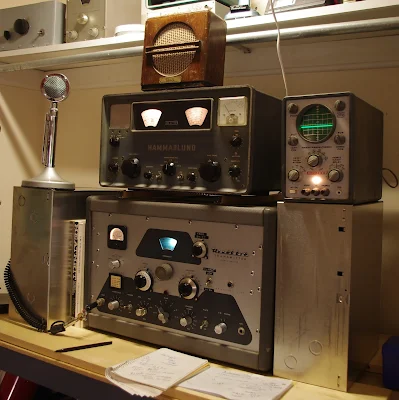From the earliest BITX articles, Farhan has encouraged the use of discarded cookie or candy boxes. Jim's popcorn box is clearly in this tradition. There is also, of course, a connection to the idea of using simple "popcorn" transistors.
Popcorn Radio
by Jim Purvis WA7HRG
While celebrating Christmas and a Birthday at Disneyland in Dec., my wife and I enjoyed a box of popcorn during one of the many parades. It was too nice a box to toss in the trash so I brought it home. It kicked around the QTH a few weeks until I caught the BitX40 v.3 fever. Wow, just enough room for the BitX and a few hacks, and the project was on. And a very neat way to remember our good time at Disneyland.
I decided on several hacks and mods and made a list. In the end I settled for less. Hihi
1. Switchable 5 or 20 watts out.
2. Single power supply. 24 volt PA with a 13 volt regulator for the rest of the radio.
3. Dual band. 40 and 20 meters.
4. SSB and digital mode operation. Built in audio interface and sound card.
5. A tune function for antenna adjustments.
6. On screen S-Meter.
7. 2.2” color TFT display. Because I can display more information and it’s just cool. The Radino it came with was set aside for another project.
I had a 24V 5amp laptop power supply as the base supply. I used two 7812 regulators in parallel and an aluminum plate heatsink and raised the common a little above ground for a 13 volt output. I could then switch that between 24V for the PA. Regulators get a bit warm when using them in the 5 watt position so most operation will be at 20 watts.
Dual band operation was soon abandoned simply do to space limitations in the box. I had no room for additional BPF and LPF.
The audio interface not only provides ground isolation and level control between the PC and the radio it also provides a VOX operation for digital modes. The digi software can provide the PSK (or other modes) audio on the left audio channel and a continuous tone on the right. I use this for the VOX operation. A ‘thumb drive’ size USB sound card provides the connection to the PC with just one cable.
Antenna tune function was provided by a version of Pete’s LBS method and I just used a small relay and a push button to activate PTT and to unbalance the balanced modulator.
The S-Meter proved problematic for me. I might not have had it if not for help and advice from Pete. It may not be accurate but provides a good relative signal strength indication. And looks very cool!
The DDS is a quagmire of several different sketches and some of my own coding. This was my first adventure into actually coding the sketch from (almost) scratch. I am sure I am very close to the maximum times you can program an Arduino as my “Guess and Test” method of coding became very arduous. All switching of mode, power and other functions are done at DC allowing me to use that as inputs on the NANO to change DDS function and displays.
All and all I am very pleased with the way it turned out. Not sure what I’ll do about losing 20 meters. Hmmm guess I’ll just have to build another radio. J
Front cover. Upper Right
corner is the Digi/SSB switch. Tuning and vol are at the bottom. All
controls and switches were located, sometimes in odd places, to retain the
graphics of the box.
In the lid. Upper left
corner is the digi/SSB switch and across the top is the audio interface
ckts. TFT is in the middle Right. Below that is the 3.3v level
shifter and encoder. On the heat sink are two 7812 regulators in parallel.
I raised the common a little above ground for 13v out. Far left is the vol
control and S-Meter amp and det ckt.
The main chassis. Across the back
left to right are power input, spk jack, mic/PTT jack, ant connector, and 5/20
watt switch. Far right is the PA heat sink. A 1x.5x4" aluminum bar.
It's what I had... Lower right corner is the tune push button and if you look
close in the upper left corner of the main board is a mini relay glued to the
board near the bal modulator. That unbalances the modulator and provides a carrier
for antenna tuning. Upper left of the box below the power connector is the USB
Sound Card for the PC interface. And a couple extra input wires I ended up not
using. Below that is the standard Nano and si5351.
Last but not least is the 2.2" TFT. All
functions power, mode, etc., are DC switched. I also use that as inputs
to the Nano for display changes. I sense the 12 v relay voltages and through a
voltage divider to input pins.
It has been a fun project and I can continue to play with
it, but I think its time to button it up and use it a little.
It's back to my General Coverage Rec that I started but
never finished.
73 Jim WA7HRG



























